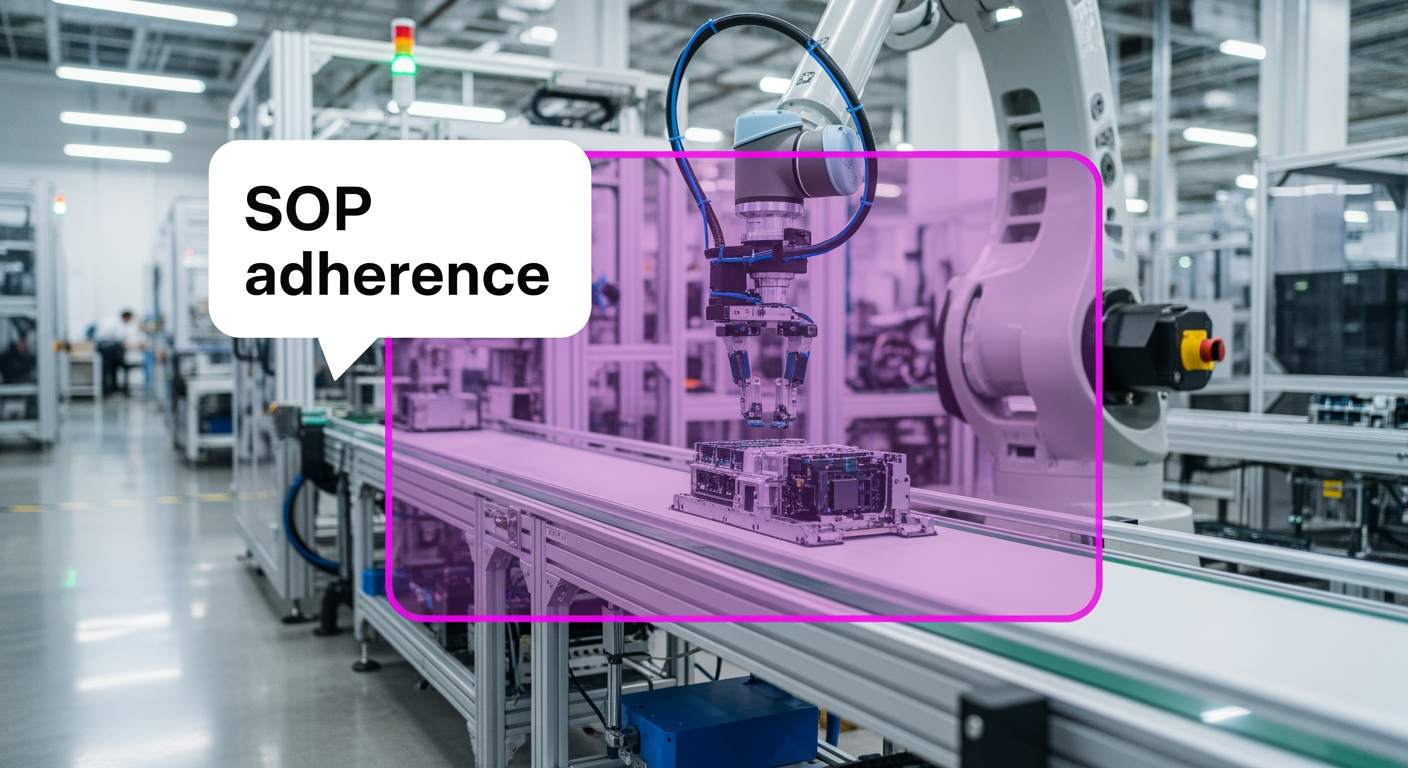Manufacturing requires a structured approach to continuous improvement that becomes embedded in your organizational DNA. For leaders focused on innovation and continuous improvement, the obstacle isn't just identifying opportunities for enhancement but creating sustainable change that delivers measurable results across all shifts, locations, and processes.
The integration of real-time visual feedback systems with proven methods like Kaizen and lean manufacturing marks a notable change in how manufacturers approach operational excellence. Companies that combine these approaches report measurable reductions in downtime and faster changeover times.
Understanding the fundamentals of continuous improvement
Continuous improvement in manufacturing shifts the strategy from reactive problem-solving to forward-looking optimization. This approach focuses on methodical enhancements that compound over time, creating sustainable competitive advantages through incremental gains rather than disruptive overhauls.
The core philosophy recognizes that small, consistent improvements across all organizational levels yield more sustainable results than large-scale changes. Manufacturing companies that adopt structured programs for continuous improvement often achieve greater operational efficiency.
Key principles of Kaizen in manufacturing
The Kaizen method forms the cultural foundation of continuous improvement, emphasizing collaborative employee involvement in identifying and eliminating waste. The approach transforms front-line workers from passive process followers into active contributors of organizational excellence.
The five-phase DMAIC framework guides Kaizen application:
Define opportunities for improvement through methodical observation
Measure current performance to establish baselines
Analyze root causes of inefficiencies using data-driven methods
Improve processes through targeted interventions
Control improvements through monitoring and standardization
Manufacturing facilities that adopt Kaizen principles report shorter production cycle times and lower defect rates. The method's success stems from its emphasis on employee empowerment, creating ownership and accountability at every level.
Lean manufacturing and waste elimination strategies
Lean manufacturing offers an operational framework for methodical waste elimination while maximizing customer value. The framework targets seven primary waste categories that impair manufacturing efficiency:
Overproduction: Creating excess inventory before demand exists
Waiting: Idle time between production steps
Transport: Unnecessary material movement within facilities
Motion: Excess worker movement due to poor workflow design
Overprocessing: Performing more work than required
Inventory: Excess materials beyond pressing needs
Defects: Production errors requiring rework or disposal
Companies that adopt lean programs reduce space requirements, increase labor productivity, and lower inventory levels.
Limitations of Traditional Improvement Approaches
Continuous improvement leaders often find conventional methodologies limiting because they rely on periodic observations and manual data collection. These traditional approaches can create operational blind spots that restrict improvement potential.
Reactive problem-solving culture
In many manufacturing environments, improvement teams are caught in a cycle of addressing issues only after they impact production. Equipment failures, safety incidents, and quality defects consume resources that could otherwise be invested in preemptive measures. This reactive approach can lead to team burnout while missing opportunities for early intervention.
Reactive management costs more than just initial production losses. Companies that operate this way often experience higher employee turnover, more safety incidents, and lower quality metrics. Without comprehensive visibility into operational patterns, improvement initiatives address symptoms rather than root causes.
Manual Gemba walks and limited visibility
Traditional Gemba walks—physical floor observations to identify improvement opportunities—offer only snapshot views of operations. These time-consuming activities may not capture critical events that occur between observations, which limits the scope of potential improvements.
A typical Gemba walk captures only a small fraction of actual operational time, leaving the vast majority of activities unobserved. This sampling approach can miss intermittent issues, shift variations, or gradual performance degradation that leads to substantial losses.
Inability to verify SOP compliance at scale
Standard Operating Procedure (SOP) adherence forms the foundation of consistent quality and efficiency. However, manual verification methods make it difficult to ensure compliance across multiple shifts, production lines, and facilities. This visibility gap leads to:
Process variations between shifts
Quality inconsistencies
Increased safety risks
Difficulty standardizing best practices
Obstacles in scaling improvements
Without automated monitoring, companies struggle to identify which procedures require refinement and which teams need additional training or support.
Using real-time visual feedback for continuous improvement
Real-time visual feedback systems transform manufacturing monitoring from periodic sampling to continuous observation. These technologies integrate multiple data sources to create detailed operational visibility, supporting both timely decision-making and long-term planning.
How visual management transforms manufacturing operations
Video AI platforms process video and other data from production equipment, quality devices, and workforce platforms in real time. This real-time processing allows for:
Swift identification of performance deviations
Timely intervention before issues impact production
Comprehensive documentation for root cause analysis
Pattern recognition across shifts and locations
Data-driven validation of improvement initiatives
Manufacturing facilities that adopt real-time visual feedback report higher operational efficiency through automated monitoring.
Digital dashboards and performance visualization
Smart manufacturing dashboards deliver role-specific information to support timely action without causing information overload. These systems convert raw data into useful information through intuitive visual displays.
Operator dashboards display real-time machine status, current production targets, quality checkpoints, and timely action items
Supervisor dashboards offer multi-line visibility, shift comparison metrics, drill-down capabilities for issue investigation, and resource allocation information
Management dashboards highlight strategic performance trends, cross-facility comparisons, financial impact metrics, and improvement initiative tracking
Companies that adopt smart dashboards can improve decision-making speed and accuracy.
Video analytics and computer vision applications
AI-powered computer vision enhances quality control and process monitoring by automating detection capabilities that surpass human observation. These systems analyze video streams to identify:
Safety violations in real-time
Process deviations from SOPs
Workflow inefficiencies
Process cycle times
The technology reduces subjective interpretation and offers steady monitoring across all production hours. Manufacturing firms that adopt computer vision report lower labor costs and enhanced workflow efficiency.
Creating a culture of continuous improvement
Technology alone cannot drive sustainable improvement—success requires cultural transformation that engages every employee in the pursuit of operational excellence. This cultural shift transforms workers from process followers to improvement champions.
Employee engagement strategies
Effective engagement begins with clear communication channels that connect workers with organizational objectives. Modern approaches utilize:
Mobile-first communication platforms that reach all workers regardless of location
Real-time feedback systems enabling two-way dialogue
Anonymous reporting mechanisms for safety and improvement suggestions
Visual communication tools accommodating diverse literacy levels
Recognition programs tied to improvement contributions
Employees who feel heard demonstrate higher engagement levels than those who lack opportunities for feedback.
Training and skill development programs
Well-designed training programs address both technical skills and mindset changes required for continuous improvement success. Effective approaches include:
On-demand learning systems accommodating shift schedules
Hands-on practice in actual production environments
Cross-functional exposure to broader operational perspectives
Mentoring relationships supporting ongoing development
Clear advancement pathways based on improvement contributions
Companies that adopt structured training programs report higher employee engagement scores.
Overcoming resistance to change
Change management is a key consideration, particularly when introducing monitoring technologies. Success strategies focus on:
Building trust through transparency about system purposes
Demonstrating how technology enhances rather than replaces human capabilities
Involving workers in deployment planning
Sharing success stories from pilot programs
Providing support during transition periods
Measuring success: KPIs and metrics
Effective measurement systems capture both quantitative improvements and qualitative benefits, and show clear connections between initiatives and business outcomes.
Essential KPIs for continuous improvement
Overall Equipment Effectiveness (OEE) remains the gold standard, combining:
Availability (actual vs. planned operating time)
Performance (actual vs. ideal production rate)
Quality (good products vs. total produced)
Additional critical metrics include:
Cycle time reduction targets
First-pass yield quality benchmarks
Changeover time reduction goals
Safety incident rate thresholds
Employee engagement participation levels
ROI calculation and business case development
Return on investment analysis must capture both direct and indirect benefits:
Direct benefits:
Labor cost reductions
Material waste decreases
Equipment utilization improvements
Quality enhancement savings
Indirect benefits:
Enhanced employee morale
Improved customer satisfaction
Reduced risk exposure
Increased organizational agility
Companies typically observe initial benefits within the first few months, with measurable returns realized within 18 months of program launch (Source: Advanced Technology Services).
Real-world success stories
Manufacturing digital transformation at Leo Paper Group
Leo Paper Group's transformation demonstrated how traditional manufacturers can enhance lean principles with digital technologies. Their integrated approach combined:
IoT equipment monitoring systems
AI vision technology for operator analysis
Unified data platforms connecting machine and human performance
Real-time cycle monitoring
Workflow optimization based on behavioral insights
Results included greater production visibility, better management of complex environments, and successful integration of disparate data sources without disrupting existing operations.
Automotive industry successes with AI quality control
In the automotive sector, BMW leveraged AI-powered video analytics to refine its quality control processes (Source: BMW). The system analyzed inspection workflows to identify process anomalies and ensure adherence to standard operating procedures. This application of computer vision demonstrated how technology can enhance human-led quality checks by providing data on process consistency and efficiency without disrupting production speeds. Key outcomes included:
Comprehensive training data development
Seamless integration with existing workflows
Methodical validation of detection accuracy
Continuous learning and adaptation
Focus on enhancing human capabilities
Technology integration best practices
Successful technology integration requires careful planning to enhance rather than complicate existing workflows. Best practices include:
Phased deployment approach
Pilot deployment in high-impact areas (3-6 months)
Validation of benefits and refinement
Progressive expansion to additional areas
Full-scale rollout with proven methodologies
Continuous optimization based on feedback
Data integration strategies
Effective integration addresses:
Compatibility with existing systems (MES, ERP, QMS)
Standardized communication protocols
Middleware solutions for seamless data exchange
Scalable architectures for future expansion
Cloud-based platforms for flexibility
Change management considerations
Comprehensive user training programs
Ongoing support rather than one-time events
Clear demonstration of benefits to users
Integration with existing improvement methodologies
Regular performance reviews and optimization
Future trends in manufacturing improvement
The evolution of continuous improvement accelerates through emerging technologies that enhance traditional methodologies while creating new optimization opportunities.
Industry 4.0 and smart manufacturing
Industry 4.0 technologies create connected ecosystems that:
Enable decentralized decision-making
Provide real-time waste identification
Maximize machine utilization through intelligent scheduling
Enhance operational responsiveness
The integration with continuous improvement methodologies amplifies benefits through data-driven findings and accelerated validation cycles.
IoT and advanced sensor networks
Internet of Things implementations offer:
Comprehensive equipment monitoring
Environmental condition tracking
Real-time quality parameter monitoring
Scalable data management solutions
Manufacturing organizations report greater equipment reliability and operational efficiency through early detection of performance deviations.
Accelerating your improvement journey
Building a culture of continuous improvement demands detailed visibility, employee engagement, and systematic approaches that deliver measurable results. Spot AI's Video AI platform offers the foundation for sustainable operational excellence by changing how organizations identify, implement, and validate improvements.
For leaders dealing with reactive problem-solving, limited visibility, and slow improvement cycles, integrating AI-powered video analytics with proven methodologies can help. By automating Gemba walks, verifying SOP compliance at scale, and exposing hidden waste, these technologies accelerate progress toward operational goals.
See how Spot AI’s Video AI platform supports your continuous improvement goals. Request a demo to experience live visibility, automated SOP tracking, and measurable results for manufacturing operations.
Frequently asked questions
What are the key principles of continuous improvement?
Continuous improvement in manufacturing rests on five fundamental principles: incremental enhancement through small, consistent changes; employee empowerment and involvement at all levels; data-driven decision making based on measurable outcomes; methodical waste elimination across all processes; and standardization of best practices to sustain gains. These principles work together to create a culture where every employee actively contributes to operational excellence through ongoing optimization efforts.
How can Kaizen be effectively applied in manufacturing?
Effective Kaizen application requires a structured approach beginning with thorough employee training on waste identification and problem-solving methodologies. Organizations should start with focused Kaizen events lasting 3-5 days that target specific improvement areas, involve cross-functional teams, and generate timely, measurable results. Success depends on visible leadership support, clear communication of objectives, structured documentation of process changes, and recognition programs that reinforce participation. With successful Kaizen events, manufacturing firms report better performance on targeted metrics.
What tools are available for real-time process monitoring?
Manufacturing environments use various real-time monitoring tools. Video AI platforms like Spot AI turn existing cameras into smart systems that monitor for safety and operational events, such as SOP deviations or workflow bottlenecks. By integrating with your existing camera infrastructure, these systems offer live visibility, allowing teams to act in seconds to correct issues and find opportunities for enhancement.
How to measure the success of continuous improvement initiatives?
Success measurement requires a detailed framework for tracking both quantitative and qualitative metrics. Key performance indicators include Overall Equipment Effectiveness (OEE) combining availability, performance, and quality metrics; cycle time reductions; first-pass yield rates; safety incident rates; and employee engagement participation levels. Organizations should also track cost reductions, higher customer satisfaction, and cultural change indicators to capture the full impact of these initiatives.
How can AI video analytics help identify the 8 wastes of lean manufacturing?
AI video analytics provide the visual data needed to uncover several of the 8 wastes that are often missed during manual observations. For example, the technology can automatically flag idle time between production steps (Waiting), map inefficient worker or material movement patterns (Motion and Transport), and identify extra, unnecessary process steps (Overprocessing). This transforms waste identification from a periodic event into a continuous, data-driven process.
How can Video AI help ensure SOPs are followed during line changeovers?
Video AI platforms can be configured to monitor complex, multi-step processes like line changeovers for SOP adherence. By defining the correct sequence and duration for each step, the system can automatically detect deviations, such as a missed action or an incorrect order of operations. This provides supervisors with timely alerts to coach operators on the spot, reducing errors that lead to startup delays and inconsistent changeover times.
About the author
Rish Gupta is CEO and Co-founder of Spot AI, leading the charge in business strategy and the future of video intelligence. With extensive experience in AI-powered security and digital transformation, Rish helps organizations unlock the full potential of their video data.

























.png)
.png)
.png)